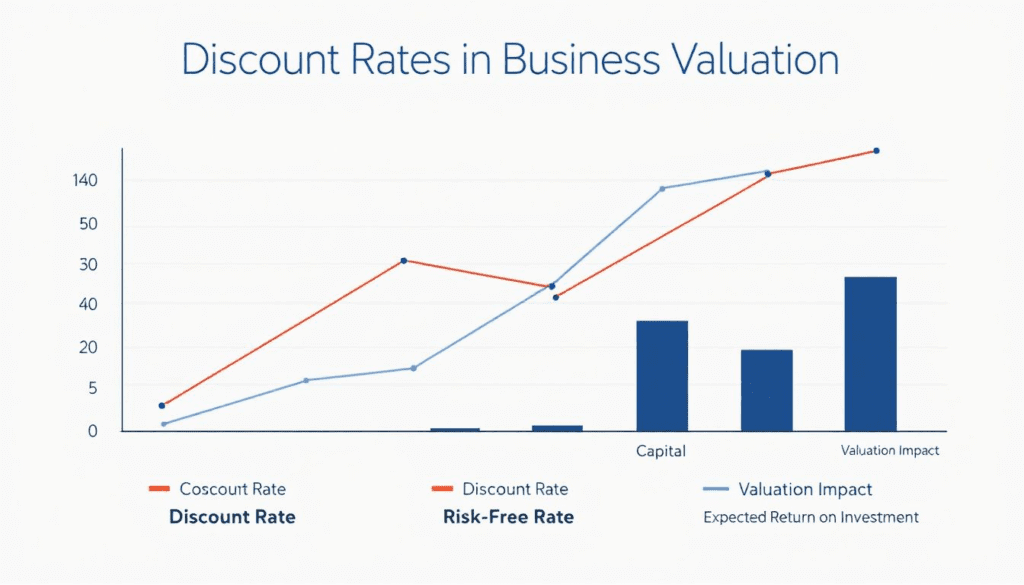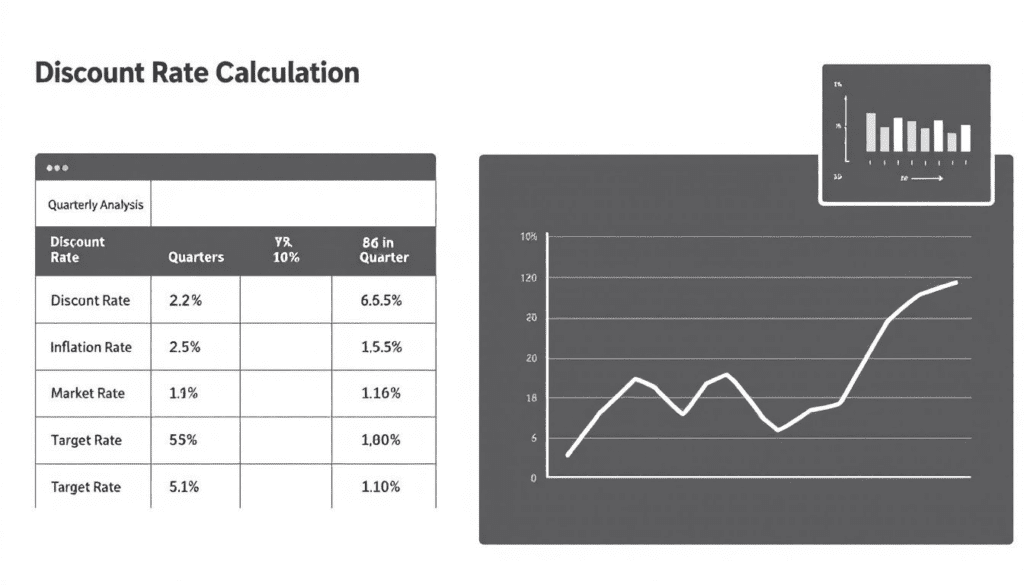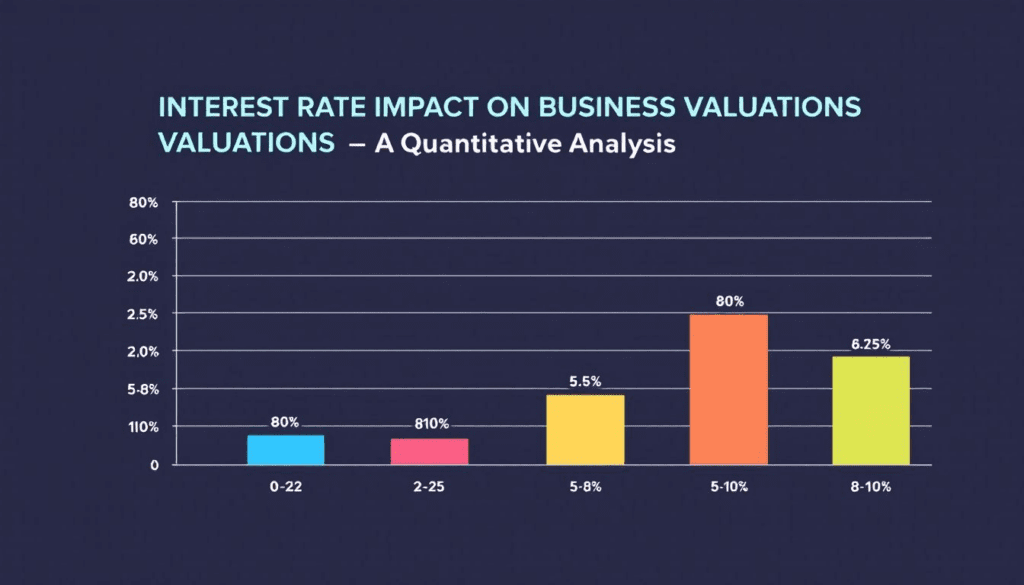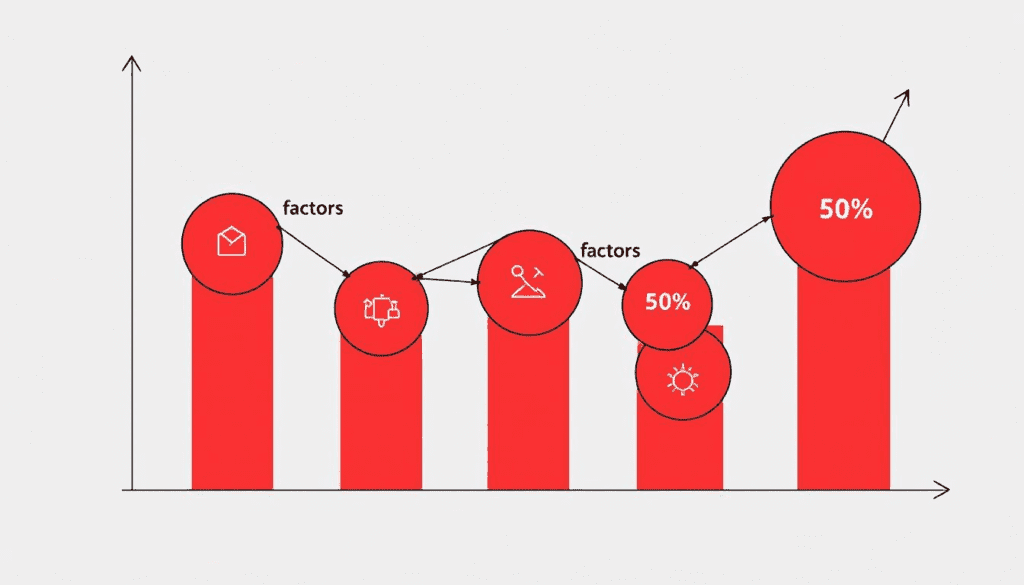What Discount Rate to Use for DCF
A business valuation discount rate is pivotal in determining the present value of future cash flows. This rate helps investors assess the potential risk and return of their investments. Understanding it is essential for making informed investment decisions. This article will explore the key concepts, importance, components, and methods of calculating the discount rate.
Key Takeaways
- The business valuation discount rate is essential for converting future cash flows into present value, impacting investment decisions and profitability assessments.
- The discount rate’s components include the risk-free rate, equity risk premium, and beta, which collectively help evaluate the risk and return associated with investments.
- The choice of discount rate directly influences business valuation, requiring consideration of factors such as opportunity cost, WACC, and market conditions to ensure realistic valuations.
- The present value of future cash flows in a discounted cash flow (DCF) analysis is determined using the discount rate, which considers the time value of money. You can also describe it by saying the discount rate is used to discount future cash flows back to their present value.
What is a Business Valuation Discount Rate?

The business valuation discount rate plays a pivotal role in converting future cash flows into present value, helping investors assess the potential risk and return of their investments. It helps determine how much value future earnings hold today, guiding investment decisions and valuations. This rate plays a critical role in the discounted cash flow method, discounting future cash flows back to their present value on the valuation date.
Typically, discount rates for business valuations fall between 12% and 20%, reflecting the risk and expected return on investment. When the discount rate is below 10%, it might indicate an overly optimistic outlook, while rates above 25% could suggest undervaluation or high risk. Due to the higher risks involved, investors expect a higher return for equity investments compared to debt.
While discount rates can seem subjective, they are an integral part of the valuation formula. They incorporate various factors, including market risks measured by beta and specific company risk premiums. Understanding and utilizing an accurate discount rate is essential for any business valuation, as it expresses the minimum return investors require, reflecting both the inherent risks and the time value of money.
Please read how to value a company for investors.
Importance of Discount Rate in Business Valuation

The discount rate is indispensable when calculating the net present value (NPV) of future cash flows and future value, a key indicator of a project’s profitability and investment risk. It ensures that the expected cash inflows from a project or investment exceed the costs, thus determining its financial viability. Higher discount rates result in lower present values of discount future cash flows, making potential investments less attractive.
An accurate discount rate is crucial for assessing new projects’ potential value. It reflects the minimum return required for an investment to be deemed worthwhile, helping investors make smarter choices. Thus, it plays a significant role in discounted cash flow analysis, directly impacting valuation outcomes.
Moreover, the discount rate expresses the expected return investors seek based on the associated risks and opportunities. This rate influences the valuation of royalty streams, debt instruments, stocks, and bonds, highlighting its importance in corporate finance and investment analysis. Selecting an appropriate discount rate ensures that the valuations are realistic and reflective of market conditions and investor expectations.
Components of the Discount Rate
The discount rate comprises several key components, each reflecting different investment risk and return aspects. At its core is the risk-free rate, typically derived from long-term government securities. This rate represents the time value of money without any risk, providing a baseline for discount rate calculations. Government securities yield is a reliable indicator for this component, ensuring a stable foundation for valuations.
Another critical component is the equity risk premium, which represents the additional return expected from investing in the stock market over a risk-free asset. This premium accounts for the inherent market risks and is vital to the discount rate formula. It ensures that the discount rate reflects the potential returns investors seek for taking on additional risk.
Beta, a measure of a stock’s volatility relative to the market, also significantly determines the discount rate. A higher beta indicates greater market risk, thus influencing the equity discount rate.
The Capital Asset Pricing Model (CAPM) integrates risk-free rate, beta, and equity risk premium components to assess an asset’s expected return. The discount rate can accurately reflect the investment’s risk and return profile by comprehensively considering these elements.
Calculating the Discount Rate

The Weighted Average Cost of Capital (WACC) and the Adjusted Present Value (APV) are two primary methods for calculating the discount rate. These methods provide robust frameworks for evaluating the present value of future cash flows, which is essential for making sound investment decisions.
The following subsections will delve into the specifics of each method, offering insights into their application and calculation processes.
Weighted Average Cost of Capital (WACC)
The Weighted Average Cost of Capital (WACC) combines the cost of equity and the after-tax debt to represent the overall cost of financing a company. It encompasses various components, including the cost of equity, debt, and the proportion of each within the company’s capital structure. Weighting these elements allows WACC to view a company’s financing costs comprehensively.
In practical terms, WACC is calculated by multiplying the cost of each capital source by its relevant weight and summing the results. For example, with a cost of equity at 10.8% and an after-tax cost of debt at 5.2%, weighted at 60% and 40%, respectively, the WACC would be a weighted sum, resulting in an overall cost of 3.2%. This calculation helps investors and managers evaluate the financial viability of projects by comparing the WACC with the expected returns.
Using WACC in discounted cash flow analysis ensures that the discount rate accurately reflects the company’s overall capital costs. It aids in determining the present value of future cash flows, guiding investment planning and decision-making.
Anyone involved in corporate finance or investment analysis must understand WACC and how to calculate it.
Adjusted Present Value (APV)
The Adjusted Present Value (APV) method benefits highly leveraged transactions by providing a detailed approach to valuation. Unlike WACC, APV separates the value of the firm’s operations from the value of financing effects. This method is expressed as APV = NPV + PV of the impact of financing. NPV represents the net present value of the project’s cash flows without financing effects, and PV accounts for the present value of financing impacts.
APV is beneficial when the company’s financing structure significantly impacts its valuation. Isolating the effects of financing allows APV to provide a clearer picture of the underlying business value. This method ensures the discount rate accurately reflects the project’s risk profile and time value of money, aiding investors in making more informed decisions.
How Interest Rates Affect Business Valuations

Interest rates play a pivotal role in business valuations by directly influencing discount rates. When interest rates rise, the discount rates used for business valuations increase, leading to a lower present value of future cash flows. This dynamic can significantly impact a business’s overall worth, as higher discount rates make future earnings less valuable in today’s terms.
For instance, a rise in interest rates can reduce business valuations by as much as 50% due to the increased discount rates. Higher interest rates necessitate a higher expected return on investments, making it more challenging to attract investors. Consequently, businesses may find it harder to secure funding or justify high valuations in a high-interest-rate environment.
Additionally, higher interest rates escalate borrowing costs, affecting a company’s capital structure and diminishing the cash flow available to equity investors. This reduction in accessible future cash flow can lead to a decline in overall business valuation, mainly when using methods like discounted cash flow (DCF) analysis.
Accurate business valuation and strategic investment planning require understanding the impact of interest rates on future value.
Interest rates also reflect the market’s thoughts on inflation. Please read our article on how inflation destroys business value.
Discount Rate vs. Cost of Capital
The discount rate and the cost of capital are closely related yet distinct financial concepts. The discount rate, also known as the rate of return, plays a vital role in finance. It is essential for calculating the present value of future cash flows from an investment. On the other hand, the cost of capital represents the required return necessary for an investment to be considered worthwhile.
Companies use the Weighted Average Cost of Capital (WACC) as a proxy for the discount rate. This approach simplifies the valuation process by providing a single rate that reflects the company’s overall financing costs. However, the discount rate is usually higher than the cost of capital to account for the additional risks associated with investing and project uncertainty.
When valuing a business, the discount rate reflects the risk associated with the business and the time value of money. This ensures valuations are realistic and aligned with investor expectations. Understanding the nuances between discount rate and cost of capital helps make informed financial decisions and accurately assess investment opportunities.
Common Pitfalls in Discount Rate Calculation
Calculating an appropriate discount rate is fraught with potential pitfalls that can significantly distort the valuation outcomes. One common mistake is using an inappropriate discount rate, which can misrepresent the project’s net present value (NPV). This issue often arises when the risk associated with the investment is not adequately factored into the discount rate.
Another frequent error is ignoring the time value of money, which can lead to a skewed valuation of future cash flows. It’s crucial to ensure that the cash flow periods are consistent with the annual discount rate to avoid confusion and inaccuracies regarding discount cash flows.
Awareness of these pitfalls enables investors and managers to improve the accuracy of their discount rate calculations and the reliability of their valuations.
Practical Examples of Discount Rate Application
Practical applications of discount rates are abundant in the business world. For example, when evaluating two companies, Company A, with larger and faster-growing cash flows, will typically have a higher present value compared to Company B. This is because the discount rate effectively captures the value of these future earnings in today’s terms.
Higher borrowing costs due to increased interest rates can also strain a company’s finances, making efficient cash flow management crucial. Applying the appropriate discount rate helps investors better assess the true value of businesses and make more informed investment decisions.
These practical examples highlight the significance of accurately calculating and applying discount rates in various financial scenarios.
Choosing the Appropriate Discount Rate

Choosing the appropriate discount rate involves considering multiple factors that reflect the required rate of return, compensating for the time value of money and investment risk. It is essential for determining the present value of future cash flows and making informed investment decisions. Credible sources of economic, industry, and company-specific risk factors should be taken into account when selecting the discount rate.
Factors such as opportunity cost, WACC, historical average returns, and the risk-free rate all influence the choice of discount rate. High-risk investments typically require a higher discount rate compared to low-risk options. Ensuring that the discount rate aligns with the expectations of stakeholders is crucial for accurate business valuation and strategic planning.
Ultimately, the appropriate discount rate helps investors and managers understand the true value of their investments and make smarter financial choices. Considering the relevant factors and aligning the rate with market conditions ensures businesses can have valuations that are realistic and reflective of underlying risks and opportunities.
Summary
Understanding and accurately calculating business valuation discount rates is fundamental for making informed investment decisions. This blog post has explored the key concepts, components, and calculations involved in determining the discount rate. We have also discussed the impact of interest rates, common pitfalls, and practical applications of discount rates in business valuations.
By integrating these insights, investors and managers can better assess the financial viability of projects and businesses. The knowledge gained from this discussion empowers you to make smarter investment choices, ensuring that your valuations are realistic and aligned with market conditions. As you apply these principles, you will be well-equipped to navigate the complexities of business valuation and achieve greater financial success.
Frequently Asked Questions
What is a business valuation discount rate?
A business valuation discount rate is essential for converting future cash flows into their present value. This allows investors to assess risk and determine the current worth of future earnings effectively.
How does the discount rate affect business valuations?
The discount rate significantly affects business valuations by determining the present value of future cash flows; higher rates decrease present values, making investments less attractive. Thus, carefully considering the discount rate is essential for accurate financial assessment.
What components make up the discount rate?
The discount rate is composed of the risk-free rate, equity risk premium, and beta, which together account for various facets of investment risk and return, leading to a precise valuation.
Why is the Weighted Average Cost of Capital (WACC) important in discount rate calculations?
The Weighted Average Cost of Capital (WACC) is crucial in discount rate calculations as it integrates both the cost of equity and the after-tax cost of debt, offering a holistic perspective on a company’s financing costs. This comprehensive view is essential to calculate discounted cash flow analysis accurately.
How do interest rates influence discount rates and business valuations?
Interest rates directly affect discount rates, with rising rates leading to lower net cash flow and higher discount rates. Consequently, this diminishes the present value of future cash flows, adversely impacting business valuations and investor appeal.
